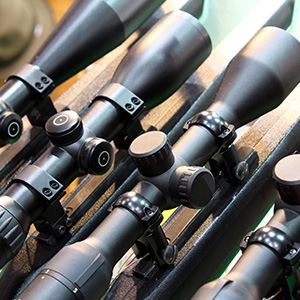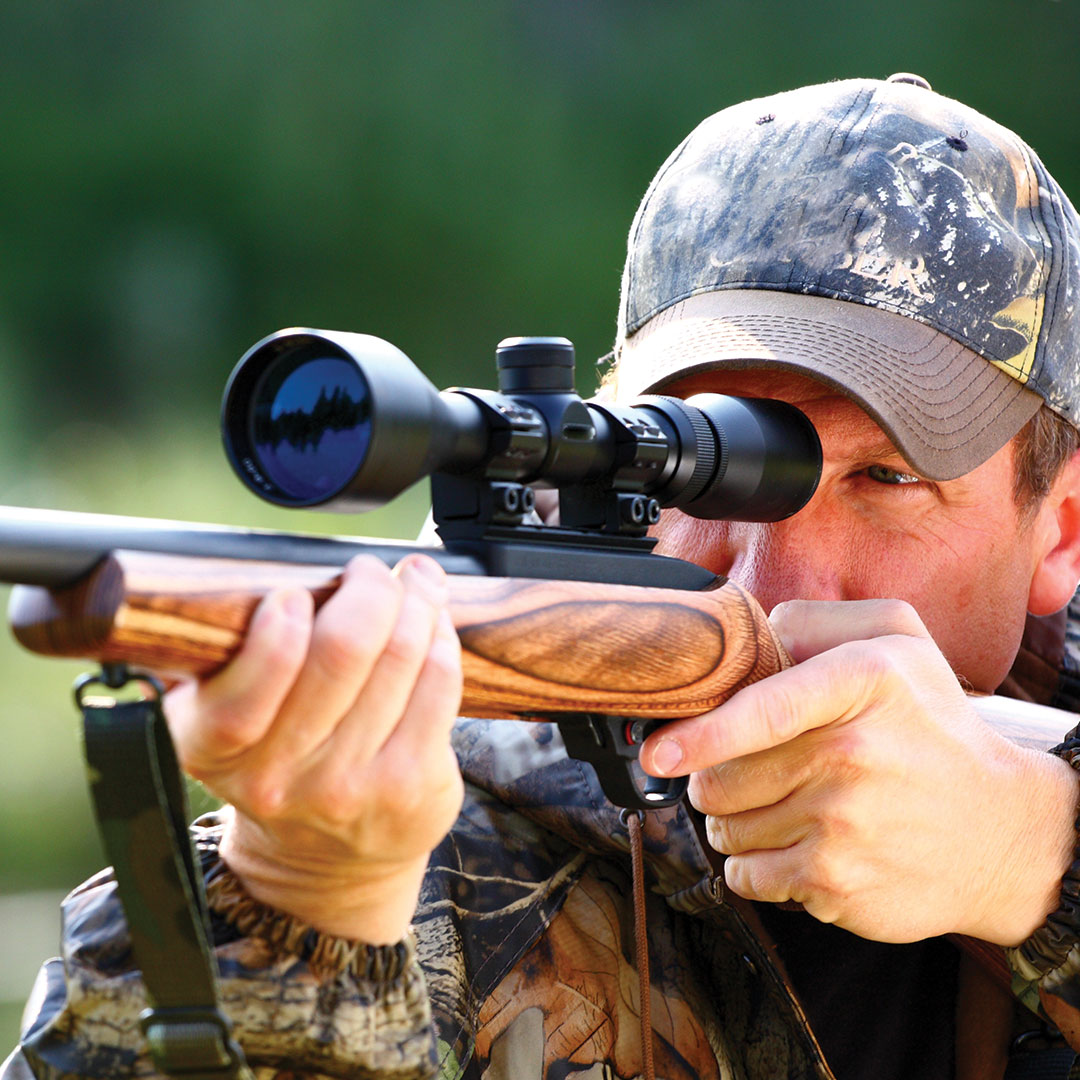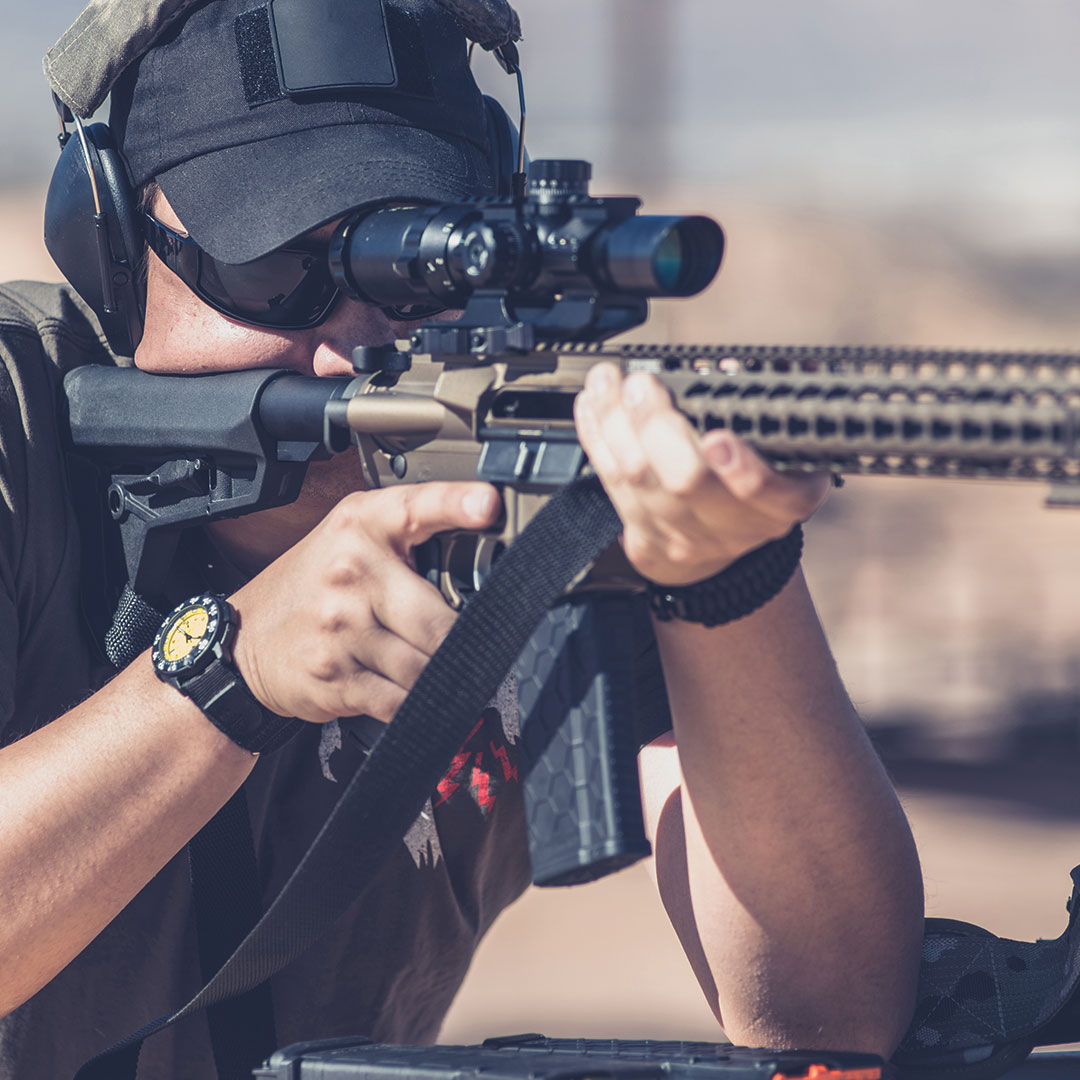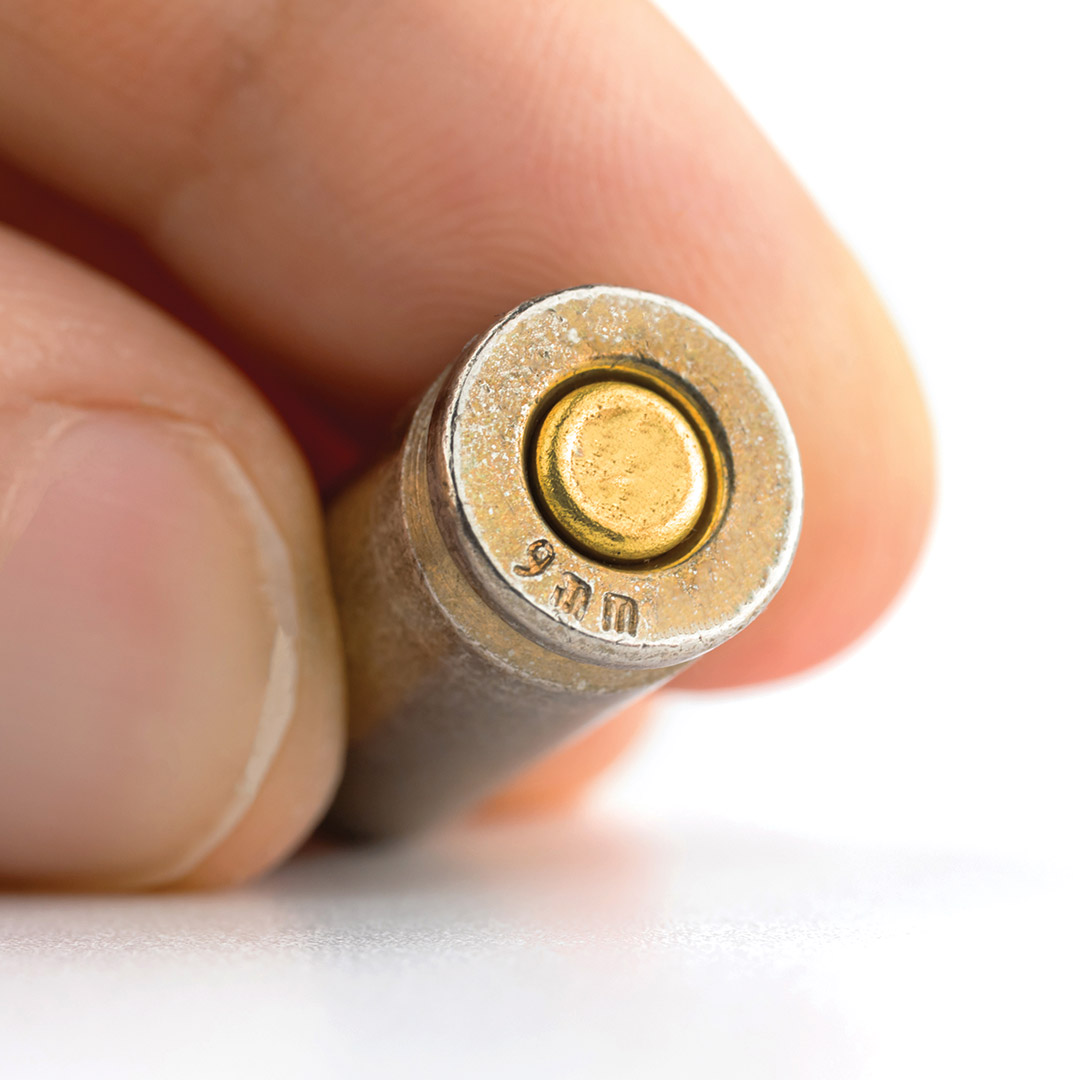
When shopping for a rifle optic, there are several different types of scopes on the market that each excel in their own areas. In this guide, we’ll break down the best types of rifle scopes and AR 15 scopes for hunting, competitive events, and other applications so that you know the features, specifications, and type of weapon scope you need to improve your accuracy and overall performance.
What is the Best Type of Scope for Hunting?

It’s hard to crown the best type of riflescope for hunting because the optimal scope for you depends on the animals you’re hunting, the environment you’re hunting in, and the distance you’re hunting from.
A good starting point is to figure out what magnification type and level you’ll want.
Fixed power scopes: provide only one magnification level.
- Pros: Consistency, are typically easier to use, and priced at a lower cost
- Cons: You can’t adjust the magnification
Variable power scopes: Provide adjustable magnification ranges.
- Pros: Versatile and offer close-, mid-, or long-range utility at the click of a turret
- Cons: Generally more expensive than fixed scopes and are more difficult to use. Don’t offer the same consistency as fixed power optics.
3-9x variable riflescopes are regarded as one of the most popular hunting scopes, and they are a safe choice for undecided hunters. At 3x, you have a large field of view to track closer, fast-moving targets like deer, and 9x is ample magnification to acquire targets 300 yards out.
I recommend using a fixed power scope if you will be hunting from the same distance on your outings. If you plan on hunting a variety of animals from different distances, then a variable power scope is best for you.
What is a Hunting Scope?
As the name suggests, hunting rifle scopes are a type of scope designed for hunting. Hunting scopes can come in a variety of forms, but true hunting optics:
- Have robust yet lightweight construction
- Are waterproof or water-resistant, fogproof, and shockproof
- Have lens coatings
- Offer easy adjustments (if variable power)
Hunting scopes need to be durable enough to withstand brutal outdoor conditions but light enough for easy carry. They should be able to handle poor weather conditions and your weapon’s recoil without compromise. Also, they should have lens coatings that enhance image brightness, providing you those precious extra minutes of daylight. Variable power hunting scopes should be easy to adjust so that you can get your shots off quicker, which is essential while hunting elk and other difficult prey.
Laser Rangefinder Scopes
Laser Rangefinder (LRF) scopes use built-in laser rangefinders to provide precise distances to targets. LRF scopes can be quite expensive, but they eliminate time-consuming calculations and inaccurate guesswork.
They are definitely worth the time and effort saved if your budget allows. However, they are not a necessity, and nothing beats the thrill of taking down big game with traditional glass.
Thermal Imaging Scopes
Thermal riflescopes provide a true “apex predator” hunting experience, allowing you to detect targets night and day through thick foliage
A thermal imaging scope:
- Can spot camouflaged prey and even track blood trails from wounded game
- Can be used 24/7, allowing you to hunt daytime or nocturnal animals without ever switching your optic
- Has a long detection range and enhanced target identification
So why is this not the obvious choice for best scope?
Price.
A good entry-level thermal scope costs around $1,200, and it only goes up from there. Therefore, I only recommend these optics to experienced hunters who can use them to their full potential. They are also the best type of scope for hog, coyote, and predator hunting.
If your budget allows, a thermal rifle scope is a highly efficient optic that cements your position on top of the food chain. Plus, they’re pretty damn fun to use.
Night Vision Scopes

Night vision riflescopes differ from thermal scopes in that they cannot be used effectively during the day. NV scopes use built-in infrared (IR) illuminators to create a bright, visible sight picture in dark settings. This makes them an ideal scope for hunting hogs, coyotes, and other nocturnal predators.
While thermal scopes can detect targets in any lighting through thick grass and extended ranges, night vision scopes are still a reliable (and far less expensive) choice for nighttime hunters. The biggest benefit is price, with Gen 1 night vision optics going for hundreds rather than thousands.
Check out this night vision vs. thermal guide to learn more about the pros and cons of these technologies.
Outside of hunting, night vision scopes are sometimes preferred by law enforcement and military because they produce clearer images, which helps with surveillance.
Scout Rifle Scopes
Scout scopes have low magnification and extended eye relief to enhance your accuracy without compromising your target acquisition speed. With a forward-mounted position, scout riflescopes are designed to be used with both eyes open, providing maximum situational awareness.
Scout rifle scopes are one of the best optics for deer hunting because they make shooting moving targets easier. You’ll also be taking your shots from shorter distances that the low power level can reach.
What is the Best Type of Scope for Varmint Hunting?
Varmints are pests that can negatively impact the ecosystem and wreak havoc on your backyard. Rodents, coyotes, and foxes are all examples of varmint, and .22LR is plenty of firepower to take them down. A rimfire rifle scope is one of the best varmint hunting scopes if you own a rimfire weapon.
Rimfire scopes are some of the cheapest optics out there, as they are usually less durable (built to handle soft recoil). If you’re just plinking pests, a 22 rimfire scope is the way to go.
What is the Best Type of Scope for Competitive Shooting?
Competitive rifle shooting comes in many forms, and the best scope for you depends on the type of event you’re competing in. For this section, we’ll cover the best optics for long-range precision competitions and 3-gun events.
Bench Rest and F-Class Shooting Competitions
When it comes to long-range and precision shooting competitions, you’ll need a scope that is capable of providing precise aiming points from 600 to over 1,000 yards, depending on the competition. Keep these features in mind while shopping for a bench rest scope:
- Quick, precise turret adjustments
- Reticles with holdover points or Bullet Drop Compensating (BDC) reticles
- Optical coatings for clarity
- Zero stop
These competitions aren’t static, and you may shoot from a variety of ranges and elevations. You will rely on your turrets to quickly adjust your optic for the next stage, and BDC reticles help you calculate optimal shot placement while accounting for distance and angle of incline/decline.
Also, target elevation may change throughout the stages, so your optic must hold zero throughout adjustments. The best type of rifle scope for these competitions is a target scope.
Target Scopes
Target scopes are long-range optics that prioritize precision and clarity. With advanced mechanical precision comes heavier equipment, but since these events don’t require much mobility, the trade-off is worth it.
Target scopes tend to be less durable than hunting scopes because you’re not expected to be shooting in poor weather conditions to harsh environments. Another thing to consider is price, as a good target scope is generally more expensive than other glass due to advanced optical lens coatings and highly technical turrets and features.
With that in mind, you need a target scope to keep up with the competition. Models can start anywhere from 10x to 25x magnification, so it’s always a good idea to research the competitions you’re interested in to know what power level is best for you.
3-Gun Competitions
3-gun competitions are aptly named for their use of pistols, shotguns, and modern sporting rifles (MSR) in matches. Target scopes are a good choice, but in 3-gun, it is more about the features your optic has rather than using a specific type of rifle scope.
Some essential features of a 3-gun scope include:
- Low-power variable magnification
- Lightweight
- Second Focal Plane (SFP) reticle
You have to be able to shoot with both eyes open in a 3-gun match. Even slight magnification can make this difficult, so your 3-gun scope needs to have 1x magnification capabilities and generous eye relief.
However, you can also expect targets from 500-600 yards out. 1-4x is enough power for 3-gun, but some matches may require a scope that goes up to 6x magnification. I recommend buying a 1-6x scope to cover all of your bases.
3-gun MSR scopes should have a similar construction to hunting scopes. You’ll be moving around a lot and need a light yet rugged optic that can hold up. Don’t be shy about spending a bit more on a high-quality scope mount, as you need a sturdy mount that reliably holds zero.
First Focal Plane (FFP) reticles change size as you adjust, whereas SFP reticles are consistent. FFP reticles may cover up close-range targets so buy a 3-gun scope with an SFP reticle for clearer shots and consistency. Upgrading to an illuminated reticle can also increase your reticle and target acquisition speeds.
Tactical Scopes
Tactical rifle scopes are preferred among law enforcement and military due to their unprecedented accuracy. When every shot counts, these are the optics you want on your weapon.
“Tactical” is a term thrown around a lot, but true tactical scopes have:
- Uncapped turrets
- Medium to high magnification range
- FFP/BDC/Illuminated reticles
Uncapped turrets are harder to adjust but offer more precise dialing.
They typically have FFP, BDC, and/or illuminated reticles for fast target acquisition and precise holdover points to calculate difficult shots. Tactical scopes can be used in a variety of applications, but they are often more expensive than other glass.
While incredibly precise, tactical scopes are optimized for the first shot, meaning they don’t offer the consistent accuracy of target scopes. You can hunt with a tactical scope if you have experience, but tactical rifle scopes are best used in military and law enforcement settings.
The Full Scope
I hope by now you have a solid understanding of what type of rifle or AR 15 scope to use for your application. As we learned, one type of scope can excel in multiple areas, and finding “the best” scope relies heavily on user preferences. In the end, aligning the scope’s features with your shooting activity will dictate what optic you should buy next.
As always, I love hearing your product recommendations, so if you have a favorite scope for a certain shooting activity, drop it in the comments below!
- What Is a Red Dot Sight Good For? - August 16, 2021
- What Binocular Magnification Is Best for Hunting? - August 16, 2021
- What Is a Training Knife? - July 23, 2021
Related Posts
« OpticsPlanet, Inc. Celebrates 20 Years of Gear™ How to Dry Fire: 5 Training Tips and Truths »





